Within the big ol’ tent of roleplaying, there is a subgenre that caters to those who enjoy unraveling mysteries, solving puzzles, and playing the role of a detective. Investigative RPGs offer a potentially very captivating experience, where players must use their wits, deduction skills, and keen observation to uncover hidden truths and solve complex cases. In this seven-part series, I’m going to have a wee look at investigative RPGs.
This final entry in the series is all about game recommendations. Here’s a wee reminder of the series to date:
- The Mechanics and Structure of Investigation
- Compelling Mysteries
- Player Agency
- Tools for Investigation
- Collaborative Problem-Solving
- Red Herrings and Plot Twists
- Game Recommendations (you are here)
Shall we proceed?
For each game, I’ll outline the genre, setting and comment on the game mechanics. I’ll then give some more background in how it fits into investigative play and end with an example scenario.
Call of Cthulhu
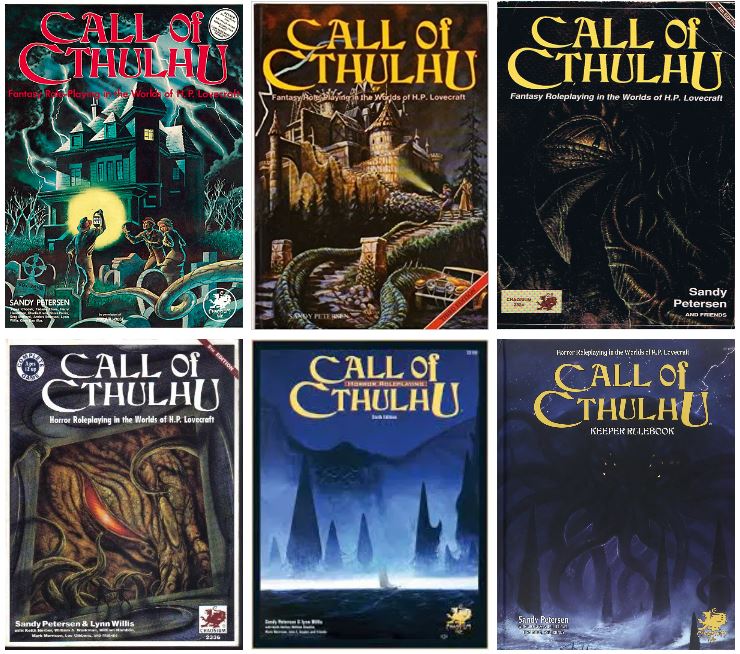
Genre: Horror, Lovecraftian
Setting: The game is set in the 1920s, although it can be adapted to other time periods as well.
Mechanics: It uses the Basic Role-Playing System (BRP), where players roll percentile dice (d100) to determine success or failure.
Reasons for Investigation-Themed Play:
- Cosmic Horror: Call of Cthulhu is renowned for its cosmic horror elements. The investigators often find themselves confronting ancient and unknowable entities that defy human understanding. Investigating these horrors gradually unravels the mysteries behind them, leading to a thrilling and often chilling experience.
- Sanity Mechanic: The game features a Sanity system, reflecting the psychological toll of facing the supernatural and witnessing gruesome events. As characters encounter the unfathomable, their sanity can erode, causing debilitating effects. This mechanic adds an extra layer of tension and role-playing depth as players must balance curiosity with the risk of losing their minds.
- Detailed Investigation: The game places a strong emphasis on investigation and problem-solving. Players need to piece together clues, interview witnesses, and research obscure texts to uncover the truth behind the eerie occurrences. It rewards thoughtful and strategic thinking, making the process of deduction a central part of the gameplay.
Example of Use: Imagine the investigators are called to a small town where a series of disappearances has left the community in fear. As they delve into the mystery, they find unsettling evidence of strange symbols, occult rituals, and rumors of a secret cult. The investigators must visit the local library to research ancient texts, talk to townsfolk who are hesitant to share information, and follow leads that lead them deeper into the heart of darkness. As they get closer to the truth, they face the horrifying revelation that the cult worships an otherworldly entity seeking to awaken and wreak havoc upon the world.
Delta Green
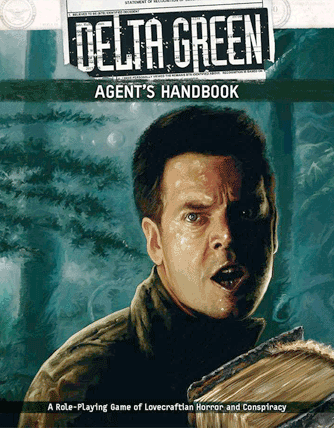
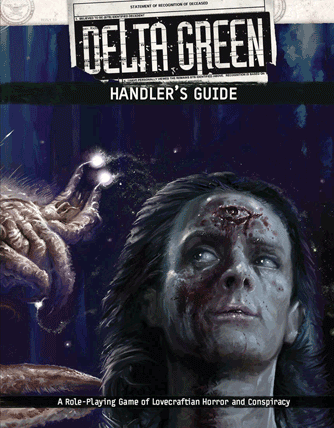
Genre: Modern Horror, Conspiracy, Espionage
Setting: The game is set in the modern-day world, with players taking on the roles of covert government agents dealing with supernatural threats.
Mechanics: Delta Green is typically played using a modified version of the Basic Role-Playing System (BRP), similar to Call of Cthulhu.
Reasons for Investigation-Themed Play:
- Government Conspiracy: Delta Green revolves around a secret organisation within the U.S. government tasked with investigating and neutralising paranormal threats. Players become agents who must navigate government bureaucracies, hide their activities from other agencies, and uncover dark conspiracies that may involve high-ranking officials.
- Moral Dilemmas: As government agents, characters may be forced to make tough choices between protecting the public, their loved ones, and their own sanity. The game often explores themes of sacrifice, duty, and the cost of wielding knowledge that could shatter the world’s perception of reality.
- Espionage and Tactical Elements: Delta Green incorporates elements of espionage and military operations. Players must carefully plan their investigations, gather intelligence, and utilise specialised equipment and training to deal with supernatural threats. This adds a layer of strategy and action to the investigative gameplay.
Example of Use: The players are part of Delta Green and receive a cryptic message about a series of gruesome murders in a small, seemingly peaceful town. The clues suggest that a powerful entity is behind the killings. As they dig deeper, they realise that a sinister cult has infiltrated the local government and law enforcement, complicating their investigation. The agents must operate covertly, using their contacts to stay ahead of the cult while keeping their own agency in the dark.
Throughout their investigation, the agents confront not only monstrous entities but also the dark secrets of their own government. They find that Delta Green’s existence is kept hidden from most government officials, and uncovering too much could jeopardise their lives and the world’s safety. The choices they make along the way will have far-reaching consequences for both the supernatural and their own humanity.
Trail of Cthulhu
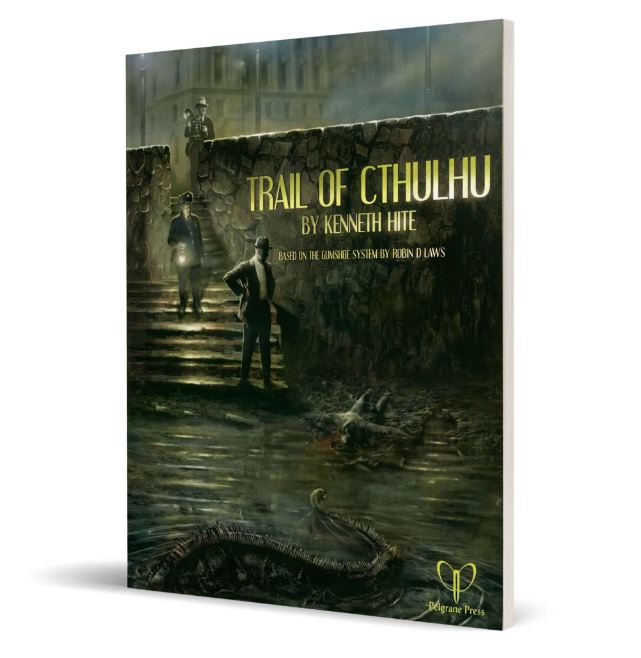
Genre: Horror, Lovecraftian
Setting: The game is primarily set in the 1930s, but it can be adapted to other time periods as well.
Mechanics: Trail of Cthulhu uses the GUMSHOE system, designed to ensure that players always find the necessary clues to advance the story. Investigative abilities automatically provide clues, eliminating the possibility of getting stuck due to failed dice rolls.
Reasons for Investigation-Themed Play:
- Streamlined Investigation: Trail of Cthulhu excels in providing smooth and focused investigation gameplay. The GUMSHOE system prevents the frustration of missing crucial clues, allowing players to concentrate on interpreting and following the leads they uncover.
- Story-Focused Gameplay: The game emphasises narrative and story progression. Players can immerse themselves fully in the mysteries and horrors of the Lovecraftian world, knowing that the plot will unfold organically based on their choices and discoveries.
- Emphasis on Pulp or Purist Playstyles: Trail of Cthulhu offers two modes of play – Pulp and Purist. The Pulp mode allows for more heroic and action-packed gameplay, while the Purist mode maintains a traditional Lovecraftian tone of helplessness and cosmic dread. Players can choose their preferred style to tailor the experience to their group’s preferences.
Example of Use: In Trail of Cthulhu, the investigators receive a package containing a mysterious artifact with cryptic symbols. They quickly discover that the artifact is linked to a series of unsolved murders across the city. The investigators use their investigative abilities, such as Archaeology, Occult, and Forensics, to decipher the symbols and uncover the ancient origins of the artifact.
As the investigators follow the trail of clues, they encounter cultists attempting to awaken an ancient entity that can bring about the end of the world. They must decide whether to confront the cultists directly or continue investigating to find a way to banish the entity back to its slumber.
Throughout the investigation, the players’ characters might slowly lose their grip on reality as they delve deeper into the forbidden knowledge and cosmic horrors that threaten their sanity.
Blades in the Dark
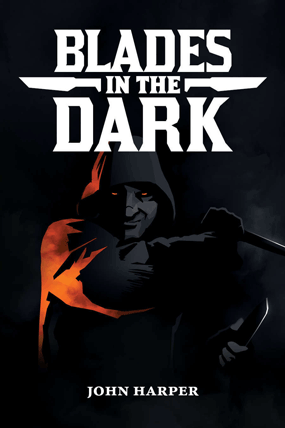
Genre: Dark Fantasy, Industrial Fantasy
Setting: The game takes place in the haunted and industrial city of Doskvol, a place filled with supernatural elements and criminal enterprises.
Mechanics: Blades in the Dark uses a unique system that revolves around heists and criminal operations. It incorporates a dice pool mechanic with various outcomes, including partial successes and complications.
Reasons for Investigation-Themed Play:
- Criminal Investigation: Blades in the Dark allows players to form a crew of scoundrels, which can include smugglers, thieves, or assassins. The crew may take on investigation-focused jobs, such as discovering the identity of a rival gang’s informant, tracking down a missing ally, or unraveling a conspiracy that threatens the city.
- Intrigue and Mysteries: Doskvol is a city filled with secrets, from hidden cults to ancient artifacts. The game’s setting offers numerous opportunities for intrigue and investigation as players delve into the mysteries lurking in the shadows.
- Diverse Abilities: Characters in Blades in the Dark have a range of abilities and specialisations, making them skilled at gathering information, sneaking into places unnoticed, and navigating the city’s underworld. This diversity enables players to approach investigations from different angles and playstyles.
Example of Use: The crew, known as “The Shadows’ Whisper,” is tasked with investigating a series of mysterious disappearances in Doskvol. They begin by gathering information from street informants and shady contacts to identify patterns and possible suspects.
As they dig deeper, they uncover that a secretive cult is behind the disappearances, sacrificing victims to summon an ancient demon. The crew must infiltrate the cult’s hidden lair, gather evidence to expose their activities, and put an end to the ritual before the demon is unleashed upon the city.
During the investigation, the crew faces complications, such as rival gangs attempting to thwart their progress or city authorities suspicious of their activities. Choices they make can influence how the investigation unfolds, affecting their relationships with factions in the city and their crew’s reputation.
The Dresden Files Roleplaying Game
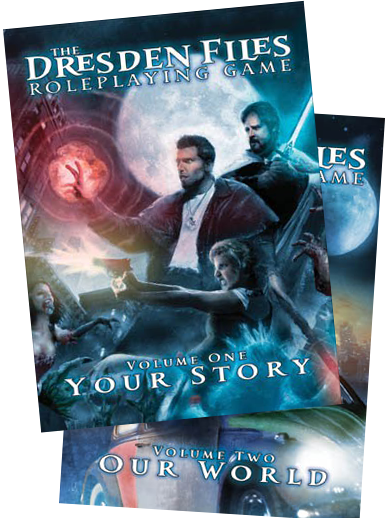
Genre: Urban Fantasy, Supernatural
Setting: The game is based on Jim Butcher’s Dresden Files series, which features a contemporary world where magic, supernatural creatures, and hidden realms coexist with the mundane world.
Mechanics: The game uses the FATE system, which emphasises narrative-driven gameplay and character development.
Reasons for Investigation-Themed Play:
- Supernatural Detective Work: In The Dresden Files RPG, players take on the roles of wizards, werewolves, vampires, or other supernatural beings who act as private investigators in a world where the mundane and supernatural collide. They face cases involving magical artifacts, missing persons, and sinister conspiracies.
- Urban Fantasy Mysteries: The setting offers a wealth of urban fantasy elements, including mystical crime scenes, hidden magical societies, and cryptic clues that provide ample opportunities for investigation.
- Evolving Stories and Characters: The FATE system encourages players to actively contribute to the narrative, shaping the direction of the story and their characters. Investigations can lead to new allies, bitter enemies, and personal growth as characters navigate the complexities of the supernatural world.
Example of Use: The players’ characters are a group of supernatural investigators operating in a city where magic and the mundane intersect. They receive a case involving a series of mysterious deaths, each victim drained of life force with no apparent cause. The investigation leads them to discover a secretive vampire coven preying on innocent citizens.
As the investigators delve deeper into the case, they must confront rival factions within the supernatural community and navigate treacherous political landscapes. The characters’ choices may lead to alliances with other magical beings who can provide vital information and support in the fight against the vampires.
Throughout the investigation, the players’ characters may encounter personal dilemmas, such as dealing with their own dark pasts, making difficult moral decisions, or forming unexpected romantic connections. The story evolves based on their choices and actions, creating a dynamic and immersive experience.
City of Mist

Genre: Urban Fantasy, Noir
Setting: The game is set in a modern-day city where mythical legends and legendary creatures are reincarnated as ordinary people known as “rifts.” These rifts are connected to powerful Mythos themes and possess unique abilities and memories of their mythic past.
Mechanics: City of Mist utilises the Powered by the Apocalypse (PbtA) system, providing a narrative-driven experience with a focus on character-driven storytelling.
Reasons for Investigation-Themed Play:
- Unraveling Mythos and Identity: City of Mist revolves around the mystery of the characters’ dual nature as rifts. The game emphasises uncovering the truth about the characters’ mythic pasts, the source of their powers, and the secrets behind the city’s existence as a nexus of mythical forces.
- Noir Detective Elements: The game blends urban fantasy with noir detective themes, creating a dark and atmospheric setting. Players take on the roles of gritty investigators, seeking to solve cases involving supernatural phenomena and uncovering the conspiracies that intertwine with their mythic backgrounds.
- Mythical Encounters: Investigations in City of Mist often lead characters to encounter legendary creatures and entities from various cultures and mythologies. Unraveling the truth behind these beings and their connections to the city’s mysteries adds a layer of depth and intrigue to the gameplay.
Example of Use: The characters are rifts, each with their unique mythic identities. They are drawn together as a team by strange occurrences in the city, such as inexplicable storms, sightings of mythical creatures, and ancient symbols appearing on city walls.
The investigations lead the characters to discover a secret society of cultists seeking to awaken an ancient deity that could unleash chaos upon the city. As they delve into the cult’s activities, the characters must confront their mythic identities and the responsibilities that come with their powers.
Along the way, the characters encounter other rifts, some of whom may be allies, while others could be foes. The investigation weaves together threads of mythology from different cultures, requiring the characters to solve riddles and decode ancient texts to piece together the cult’s plan.
Throughout the investigation, the characters may face dilemmas, both personal and ethical, as they grapple with their dual identities and the consequences of wielding mythic power in the modern world.
Night’s Black Agents
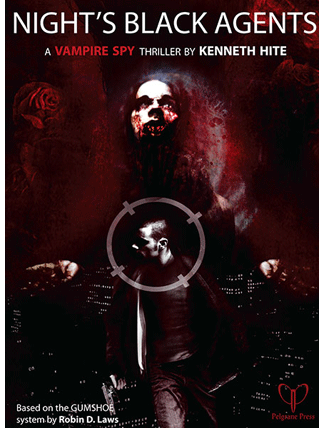
Genre: Espionage, Vampire Horror
Setting: The game combines the thrilling world of espionage with the dark and dangerous realm of vampires and the occult. Players take on the roles of skilled spies and covert operatives fighting against a conspiracy of powerful vampires.
Mechanics: Night’s Black Agents uses the GUMSHOE system, which focuses on investigative gameplay and ensures that players always find the necessary clues to move the story forward.
Reasons for Investigation-Themed Play:
- Espionage and Action: Night’s Black Agents offers a thrilling mix of espionage and high-octane action. Characters may investigate vampire conspiracies, gather intel, and plan elaborate heists, all while facing deadly supernatural adversaries.
- Vampire Conspiracy: The game immerses players in a world where vampires wield influence over powerful organisations and governments. The investigation leads the characters to unravel the vampire conspiracy’s intricate web, exposing its leaders and thwarting their sinister plans.
- Supernatural Powers: While the characters themselves are skilled agents, they may encounter supernatural abilities and forces related to the vampires. Investigating these powers and learning how to counter them becomes crucial to their survival.
Example of Use: The players portray a team of former intelligence agents who’ve become disavowed due to uncovering evidence of a vampire conspiracy within their organisation. They embark on a rogue mission to dismantle the vampire network while avoiding their former employers.
The investigation takes them to various international locations, tracing the trail of money, political influence, and mysterious disappearances that all lead to the vampire cabal. The agents must use their spy skills to infiltrate vampire-controlled operations, gather evidence, and recruit allies within the supernatural underworld.
As the investigation progresses, the agents face the dark powers wielded by the vampires. They discover ancient artifacts, ritualistic symbols, and even evidence of other supernatural creatures allied with the vampire conspiracy.
Throughout the campaign, the characters must confront their fears and vulnerabilities, as they know that one misstep could lead to their exposure and eradication by the vampires or their human minions.
Fear Itself
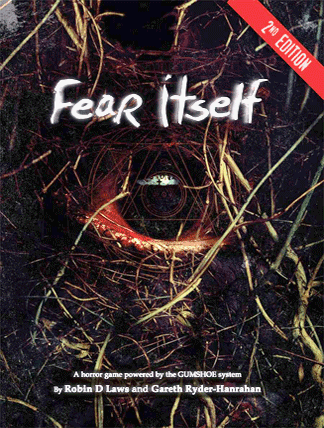
Genre: Horror, Psychological Thriller
Setting: Fear Itself is a horror RPG where players take on the roles of ordinary people who find themselves facing terrifying and otherworldly threats. The game focuses on psychological horror, emphasising the characters’ fears and vulnerabilities.
Mechanics: Fear Itself uses the GUMSHOE system, designed to keep the investigation flowing smoothly and ensure players always find essential clues to move the story forward.
Reasons for Investigation-Themed Play:
- Everyday Heroes: In Fear Itself, players portray regular individuals with no special powers or training. They are ordinary people thrust into extraordinary and horrifying situations, making their investigation-driven efforts to survive all the more intense and relatable.
- Personal Horror: Fear Itself centers on psychological horror, exploring the characters’ fears and inner demons as they face supernatural terrors. The investigation often leads the characters to confront their darkest secrets and regrets.
- Investigation as Catharsis: The game’s investigative focus provides an opportunity for players to explore the mysteries and horrors that plague their characters. Facing these fears head-on can be cathartic and lead to character growth as they overcome their personal struggles.
Example of Use: The players create characters, each with a specific fear or trauma from their past. They are brought together by a shared experience, such as witnessing a paranormal event or encountering an enigmatic symbol that haunts their dreams.
As the investigation begins, the characters find themselves drawn into a series of disturbing events connected to an ancient ritual performed in the town’s outskirts. As they delve deeper into the mystery, they uncover a malevolent entity that preys on their fears and vulnerabilities.
Throughout the investigation, the characters must confront not only the supernatural entity but also their personal demons. They are forced to confront the traumatic events of their past, whether it’s a childhood trauma, a personal failure, or an unresolved loss.
As they work together to overcome both external and internal horrors, the characters may find strength in each other and develop bonds of camaraderie. The investigation becomes a journey of self-discovery and healing, even as they risk their lives to stop the malevolent force threatening their town.
Chronicles of Darkness
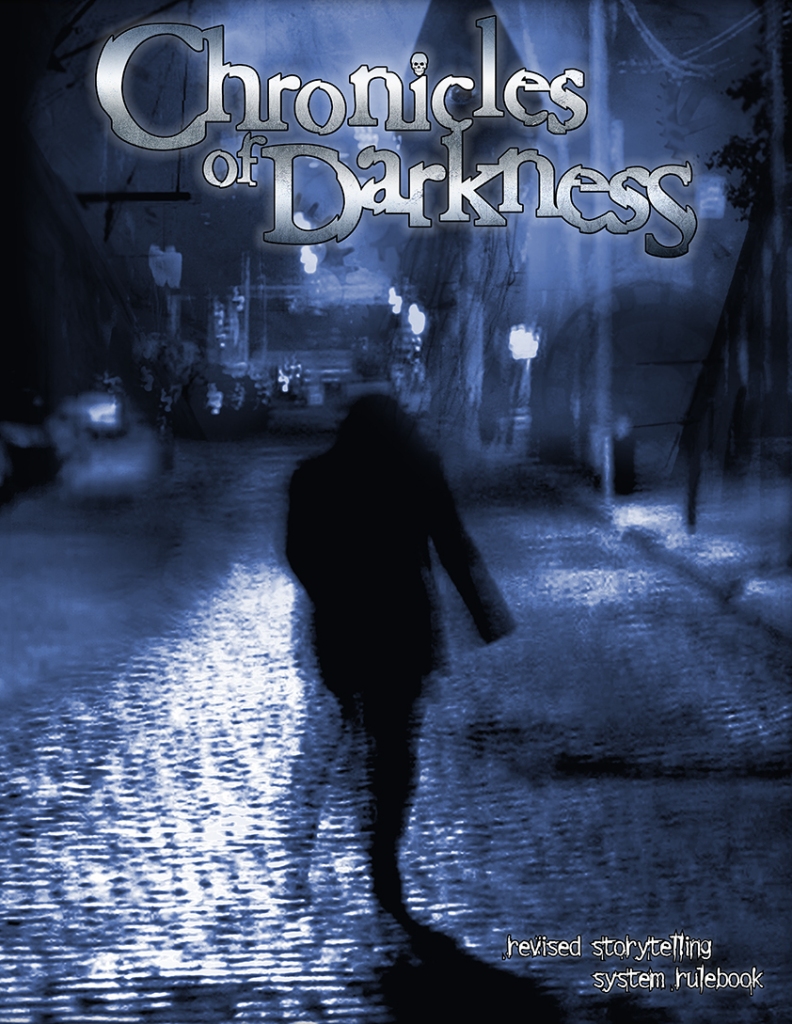
Genre: Supernatural, Horror, Urban Fantasy
Setting: Chronicles of Darkness is a series of RPGs that include various game lines, each focusing on different supernatural creatures, such as vampires, werewolves, mages, and more. The setting is a modern-day world where these supernatural beings exist in secret alongside mundane society.
Mechanics: Chronicles of Darkness uses a storytelling system that emphasises character-driven narratives and flexible rules for handling various supernatural abilities and challenges.
Reasons for Investigation-Themed Play:
- Supernatural Intrigue: Chronicles of Darkness provides a rich backdrop for investigations, as the characters explore the hidden world of the supernatural. Whether it’s solving a vampire’s murder, tracking down a rogue werewolf, or unearthing the secrets of an ancient mage order, the game offers a plethora of opportunities for investigation.
- Rich Lore and Mythology: Each game line within Chronicles of Darkness has its own lore and mythology, giving players a chance to delve into the intricacies of different supernatural beings and factions. The investigations often lead to deepening the understanding of these creatures and their hidden societies.
- Morality and Humanity: The game often explores themes of morality and the struggle to maintain one’s humanity or sanity while dealing with supernatural forces. Investigations can push characters to confront their ethical beliefs and personal values in the face of dark and extraordinary challenges.
Example of Use: In a Chronicles of Darkness game focused on vampire characters, the players portray a coterie of vampires living in a bustling city. They receive information about a series of brutal murders, all pointing to a pattern that seems to involve a vampire masquerading as a serial killer.
The investigation leads the coterie to interact with other supernatural beings, such as werewolves who protect their territory and mages who may possess valuable information. The characters must navigate the complexities of the supernatural society, forming alliances and dealing with rival factions while trying to uncover the truth behind the murders.
As the investigation progresses, the characters may grapple with their vampiric nature and the need to feed on human blood, testing their humanity and moral compass. They must also contend with the authorities, both human and supernatural, who might seek to stop their investigation or exploit the situation for their benefit.
Throughout the story, the characters face personal dilemmas, such as confronting their own dark pasts, making difficult choices to protect their loved ones, or resisting the allure of their vampiric instincts.
Mutant City Blues
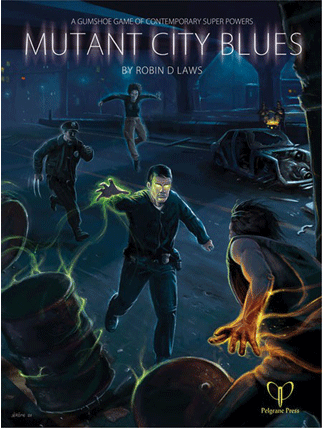
Genre: Superhero, Police Procedural, Mystery
Setting: The game is set in a world where a percentage of the population possesses mutant powers. Players take on the roles of police detectives working in the Heightened Crimes Unit, investigating crimes involving mutants and their unique abilities.
Mechanics: Mutant City Blues utilises the GUMSHOE system, which focuses on investigation and ensures that players always find the necessary clues to advance the story.
Reasons for Investigation-Themed Play:
- Police Procedural Investigation: Mutant City Blues provides a refreshing take on the superhero genre, focusing on the investigative aspects of being a police detective rather than typical superhero action. Players must gather evidence, interview witnesses, and piece together clues to solve cases involving mutants and their powers.
- Unique Mutant Abilities: The game showcases a diverse array of mutant powers, such as telekinesis, mind control, and elemental manipulation. Investigating crimes involving these powers requires a deep understanding of how they work and their potential applications as weapons or tools.
- Mystery and Intrigue: Each investigation presents a unique mystery, whether it’s tracking down a telepathic serial killer or unraveling the enigma of a seemingly innocuous mutant who suddenly manifests dangerous abilities. Players must navigate complex webs of clues and confront unexpected twists to solve the cases.
Example of Use: The players’ characters are part of the Heightened Crimes Unit, a specialised division of the police force dedicated to investigating crimes involving mutants. They are called to a scene where a bank robbery occurred, and surveillance footage shows a mutant with invisibility powers committing the crime.
As the investigation unfolds, the detectives uncover that the bank robbery is just the tip of the iceberg. They find connections to an underground mutant fight club and a mysterious organisation that seems to be manipulating mutants for their own purposes.
The detectives must use their investigative skills and knowledge of mutant abilities to track down the invisible culprit and uncover the true mastermind behind the crimes. Along the way, they might encounter other mutants, some of whom are victims, while others may be suspects or potential allies.
Throughout the investigation, the characters may face moral dilemmas, such as dealing with the ethical implications of enhanced abilities and how society perceives and treats mutants.
Bubblegumshoe
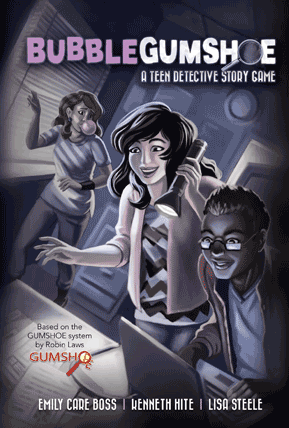
Genre: Mystery, Teen Drama, Noir
Setting: The game is set in a high school or teenage environment, where players portray young characters navigating the challenges of adolescence while solving mysteries and uncovering secrets.
Mechanics: Bubblegumshoe uses the GUMSHOE system, adapted for a teen-centric setting, focusing on investigation and empowering young characters to uncover the truth.
Reasons for Investigation-Themed Play:
- Teen Detectives: Bubblegumshoe allows players to step into the roles of teen detectives, solving mysteries in their high school, local community, or small town. The game captures the essence of young characters uncovering secrets and navigating the complexities of teenage life.
- Character Drama: In addition to the investigative aspect, the game emphasises the emotional and social drama of being a teenager. Characters deal with relationships, school pressures, family issues, and personal struggles while trying to crack the cases they encounter.
- Age-Appropriate Adventures: Bubblegumshoe offers age-appropriate content, focusing on mysteries and dilemmas that resonate with teenagers. The game provides a safe and engaging space for young players or those who enjoy role-playing in a teenage setting.
Example of Use: The players’ characters are students at a suburban high school, where strange occurrences have been happening. It begins with rumors of a haunted locker, followed by the disappearance of a prized class pet and other seemingly unrelated incidents.
The characters decide to investigate, forming a detective club to uncover the truth behind these strange events. They interview their classmates, sneak around after school, and research local legends to find connections between the seemingly isolated incidents.
As the investigation progresses, the characters start to uncover a hidden conspiracy among a group of rival students who are using the school’s reputation for ghosts to their advantage. They aim to shut down a rival club and take over the school’s social scene.
Throughout the investigation, the characters experience typical teenage drama, such as navigating crushes, dealing with peer pressure, and managing academic responsibilities. The mysteries they unravel provide them with valuable life lessons and insights into the challenges of adulthood.
Conclusion
These seven RPG systems offer diverse settings, mechanics, and approaches to investigative gameplay, ensuring that there’s something for every mystery-solving enthusiast. Ultimately, any system can be suitably adapted for use in investigative play. Remember to choose the system that best aligns with your desired playstyle and the specific genre or setting you wish to explore.
I’ve enjoyed putting together this series, and I hope to maintain this Saturday slot for RPG-focused discussion. Next week, let’s take a look at how tabletop roleplaying games harken back to humanity’s oral tradition.
I the meantime, happy sleuthing!

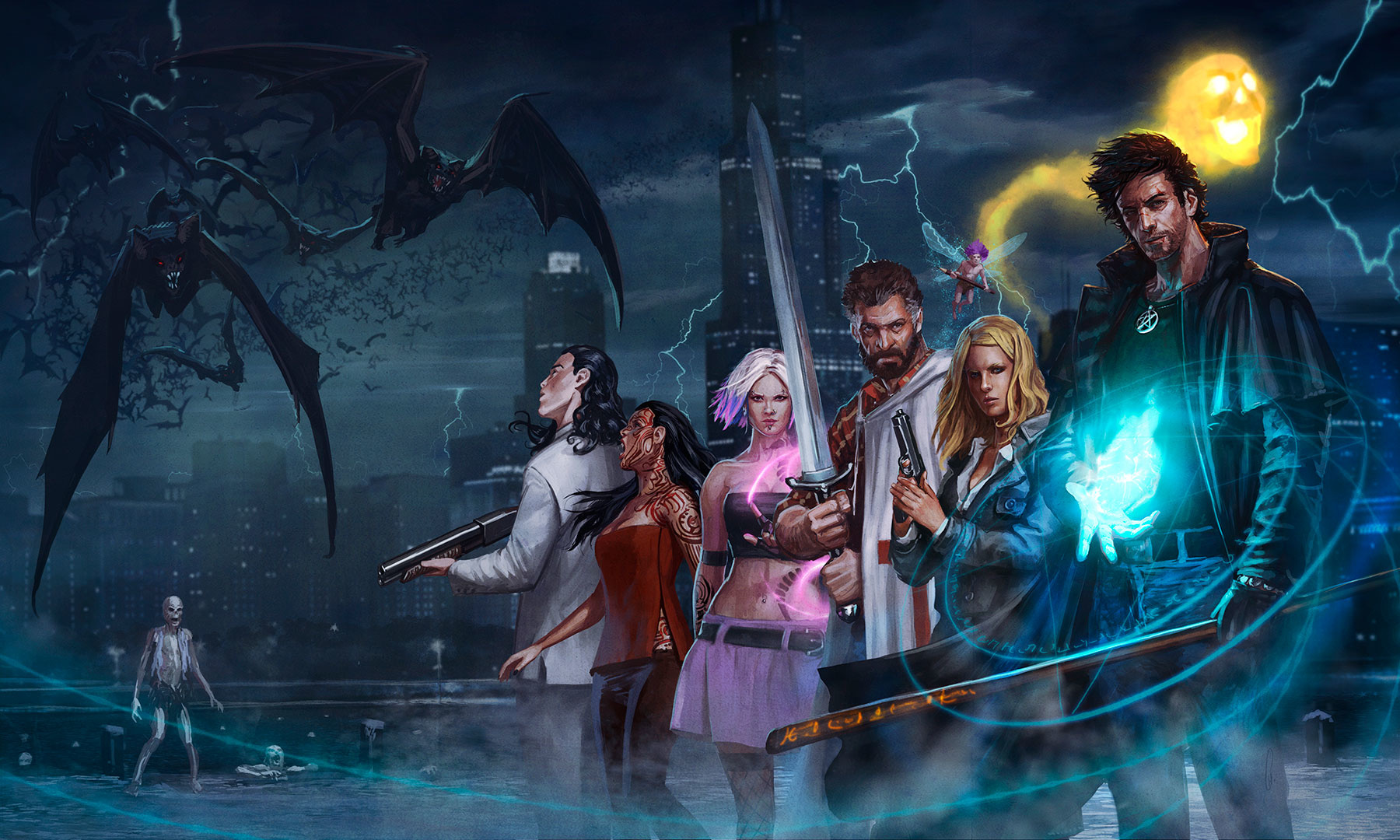
8 Comments